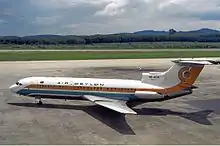Air Ceylon
Air Ceylon was the former flag carrier airline of Ceylon (now Sri Lanka). The airline discontinued flights to Europe in early 1978 and finally ceased all local services on 31 August 1979, when it was replaced by Air Lanka and then rebranded to SriLankan Airlines later.[2]
 | |||||||
| |||||||
| Founded | 1947 | ||||||
|---|---|---|---|---|---|---|---|
| Ceased operations | 1979 | ||||||
| Hubs | Colombo–Ratmalana (1947-1967) Colombo–Bandaranaike (1967-1979) | ||||||
| Fleet size | 2 (1979) | ||||||
| Destinations | 24 | ||||||
| Headquarters | Colombo, Ceylon | ||||||
History


Air Ceylon was established in 1947 as state-owned flag carrier airline. In 1947, the Government purchased 3 DC- 3s which were all named after queens Sita Devi, Viharamaha Devi and Sunethra Devi. Wednesday 10 December 1947, with Capt. Peter Fernando at the controls and a complement of 16 passengers, Sita Devi took-off from Ratmalana runway soon after 8 a.m. inaugurating the Air Ceylon commercial flights and headed for Palaly. After a brief stop there, the Dakota proceeded to Madras, returning to Colombo by the same route later that day.Madras-Jaffna-Trichinopoly Douglas C-47 Skytrain Services to London with two Douglas DC-4s leased from Australian National Airways (ANA) commenced in summer 1949, after ANA acquired a 49 percent stake in Air Ceylon earlier that year.[3][4] Flights to Sydney in a co-operation with ANA were started on 20 July 1950 via Singapore and Darwin.[5]
Air Ceylon discontinued all long-haul fights and gave up its partnership with ANA in September 1953 after BOAC had introduced de Havilland Comet between London and Colombo.[6][7] The 49 percent stake held by ANA was taken over by KLM in 1955.[8]
Flights to London were commenced again on 21 February 1956 using a Lockheed 749A Constellation leased from KLM.[9] The aircraft was replaced by a Lockheed L-1049 Super Constellation in 1958, followed by a KLM Lockheed L-188 Electra that was leased until the partnership with KLM ended in November 1961.[10] A Comet from BOAC allowing the re-launch of flights to London in April 1962. The aircraft was replaced by a leased Vickers VC10 in November 1965.[11]
From 1964 the Hawker Siddeley HS 748 became the aircraft mainly used on Air Ceylon's short-haul routes to Madras and Bombay, along with the Aérospatiale N 262, that was bought in 1967. When Bandaranaike International Airport was completed in 1967, Air Ceylon opened its hub there. A Hawker Siddeley Trident jet airliner was purchased in 1969 and it was operated on regional routes until it was withdrawn in August 1979.[12][13]
In 1972, Union de Transports Aériens (UTA) became Air Ceylon's partner, selling one Douglas DC-8 to the airline and giving technical support. UTA ended the partnership in September 1976, leaving Air Ceylon without a European aide.[14] In 1979, Air Ceylon was shut down by the Sri Lankan government due to bankruptcy, and Air Lanka was established as new national carrier.
During that period, Air Ceylon offered multiple-stopover flights, which were leaving Colombo on three routes: To Europe, to Australia, and a regional one to India. KLM was the important partner airline, serving as general sales agent for Air Ceylon.[15][16]
Due to more modern aircraft with a longer range, fewer stops were required on the long-distance routes, reducing travel time. Air Ceylon passengers could reach additional destinations (in Europe and towards Australia) with co-operative BOAC or Qantas flights.[17]
The co-operation with BOAC and Qantas was reduced at that time, instead a codeshare-like agreement was signed with Indian Airlines. As a consequence, Air Ceylon re-launched services to Australia and expanded its European network.[18][19][20]
Terminated Destinations
Fleet
Before ending operations in 1979, Air Ceylon had 1 Hawker Siddeley HS 748 and 1 Hawker Siddeley Trident.
Over the years, Air Ceylon operated the following aircraft types
| Aircraft | Introduced | Retired |
|---|---|---|
| Aérospatiale N 262 | ||
| Boeing 707 | ||
| Boeing 720 | ||
| Convair 990 Coronado | ||
| de Havilland Comet | ||
| Douglas DC-3 | ||
| Douglas DC-4 | ||
| Douglas DC-8 | ||
| Hawker Siddeley HS 748 | ||
| Hawker Siddeley Trident | ||
| Lockheed Constellation | ||
| Lockheed Super Constellation | ||
| Lockheed L-188 Electra | ||
| Sud Aviation Caravelle | ||
| Vickers VC10 | ||
Accidents and incidents
- On 21 December 1949, an Air Ceylon Douglas C-47 Dakota (registered VP-CAT) was damaged beyond repair in a crash landing at Tiruchirapalli Airport following a scheduled passenger flight from Jaffna. The 21 passengers and three crew members survived the accident.[21]
- On 7 September 1978, an Air Ceylon Hawker Siddeley HS 748 (registered 4R-ACJ) was destroyed by a on-board bomb and subsequent fire while parked at Ratmalana Airport. Two pilots had been carrying out pre-departure checkups, when the fire started by the explosion of a bomb in the aircraft.[22]
References
- Klee, Ulrich; Bucher (1978). JP Airline-Fleets International (78 ed.). Switzerland: Editions JP. ISBN 3857581123.
- Flight International, 26 July 1980
- Flight International, 23 June 1949
- Flight International, 3- February 1949
- Flight International, 25 January 1950
- Flight International, 17 April 1953
- Flight International, 19 June 1953
- Staniland, Martin (2003). Government Birds, Air Transport and the State in Western Europe. Lanham: Rowman & Littlefield Publishers. ISBN 0-7425-0124-8.
- Flight International, 16 March 1956
- Flight International, 14 September 1961
- Flight International, 3 June 1965
- Flight International, 29 May 1969
- Klee, Ulrich; Bucher (1979). JP Airline-Fleets International (79 ed.). Switzerland: Editions JP.
- Flight International, 26 June 1976
- Air Ceylon 1953 timetable at timetableimages.com
- Air Ceylon 1959 timetable at timetableimages.com
- Air Ceylon 1967 timetable at timetableimages.com
- Air Ceylon 1970 timetable at timetableimages.com
- Air Ceylon 1972 timetable at timetableimages.com
- Air Ceylon 1974 timetable at timetableimages.com
- Air Ceylon 1949 accident at the Aviation Safety Network
- Air Ceylon 1978 bomb incident at the Aviation Safety Network
| Wikimedia Commons has media related to Air Ceylon. |